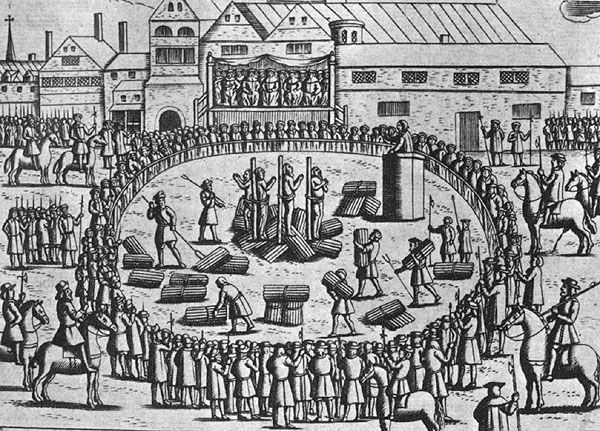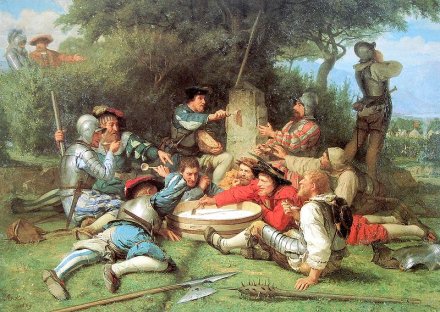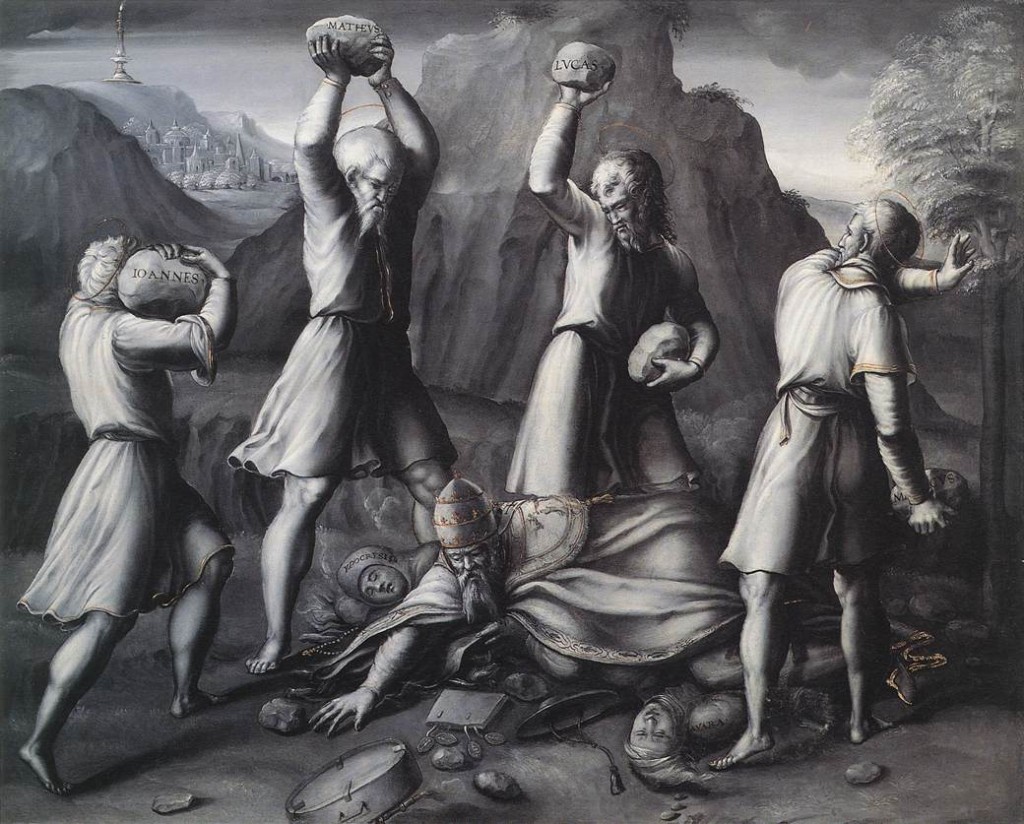Is history without meaning, without power and without hope ? …
…Even if professionals hold up their hands in horror at the idea of drawing lessons from history, others, far less capable, do not. Toynbee had no hesitation in trampling where Namier feared to tread. And before Toynbee, Oswald Spengler displayed no less confidence and no less absurdity. Both regarded history as a whirligig in which decay was as frequent as growth.

---ANNE ASKEW BORN: 1521 EXECUTED: 16 JULY 1546 Woodcut of the burning of Anne Askew at Smithfield in 1546 British Museum---Read More:http://tudorhistory.org/people/askew/
Toynbee dismissed European history from the seventeenth century onward as an uninterrupted disaster; Spengler declared in 1928 that the West was in its “sunset epoch,” that the world had gone straight downhill since the eighteenth century. Both of them encouraged despair about the present, neither considered material progress as relevant. They were the progenitor types, the composite used in Edward Albee’s Who’s Afraid of Virginia Wolf?, and their vision of history tends to persist and distorts the truth.
Yet if there is one idea that makes sense of history, it is the idea of progress. The idea is simple: over the centuries, in spite of frequent setbacks, the material condition of people has improved. People live longer, get more to eat, are freer from disease, possess more leisure. The speed of progress has accelerated phenomenally over the past two hundred years and shows all prospect of continuing to do so. Place a hand loom by a smartphone; the case is unarguable.

---The short-lived Erster Kappelerkrieg — the First War of Kappel — was won within weeks, swiftly concluded by a truce favorable to Zwingli’s Protestant alliance. (Legend has it that the treaty was concluded over a shared pot of milk soup picturesquely resting on the Catholic-Protestant border, the Kappeler Milchsuppe.)---Painting: Die Kappeler Milchsuppe (1869) by Gemälde von Albert Anker.--- But this initially favorable return on poor Jacob Kaiser’s sacrifice was soon squandered. Hostilities between the two camps continued, eventually flaring into the Second War of Kappel. Zwingli was again spoiling for the fight, but his under-prepared Protestants were trounced by a Catholic league in October 1531. Zwingli himself died on the battlefield.---Read More:http://www.executedtoday.com/2010/05/29/1529-jacob-kaiser-ulrich-zwingli-first-war-of-kappel/
With this material progress has gone an increase in civility. And this, many, for obvious reasons, find difficult to believe. To those not well grounded in history, but conscious of Hitler’s Jewish policy, two world wars, Atomic bombs, to say nothing of Rwanda, Stalin’s camps, Syria, Libya et al.; this claim may appear almost naively optimistic. Yet it is true. The world is less savage, less brutal, less tyrannical than it was even fifty years ago, if we are willing to exclude the Iran/Iraq war and its million casualties or Pol Pot.
How progress has happened and is happening is complex, not entirely understood, but it is certainly the most intellectually fascinating aspect of history. It ought to be the core of historical study and education, particularly the latter. It relates directly to the scientific and technical world in which we live. And furthermore the interpretation of how this has happened and might be accelerated would give a renewed sense of social purpose to the teaching of history.

---Anti-papal painting by Girolamo da Treviso, "A Protestant Allegory" (source - The painting refers to the English Reformation, formally sanctioned by the Act of Supremacy of 1534, whereby Henry VIII broke away from the Church of Rome and was established as head of the Church of England. The painting was in the collection of Henry VIII who owned at least two other anti-papal pictures. The composition comprises a pope sprawling on the ground, flanked by two female figures representing avarice and hypocrisy, all of whom are being stoned by the four evangelists. On the ground in front of these figures are a cardinal’s hat and a document with four seals (probably a Papal Bull). The city in the distance on the left may be Jerusalem.---Read More:http://filipspagnoli.wordpress.com/2012/01/03/why-do-we-need-human-rights-29-human-rights-as-expressions-of-human-duties-in-early-protestant-thinking/
The history of progress could at least breed confidence in the present and the future, dispel Edward Albee’s nightmare, throw the Heidegger’s with their purity of an idyllic past of pure “volk” under the bus where they belong, and fortify those qualities in people that have helped them drag themselves form caves of ignorance to the modern context. But there also lies the rub.
p>To many, and included here can be included religious reactionaries, the idea that people should pursue material progress is anathema: for them as for Toynbee, it is vulgar; destructive of spiritual values; repellant in its social and artistic manifestations; totally destructive of what a F.R. Leavis once called “organic community.”
Now the opposition to the idea of progress , conscious or unconscious, derives from three of its aspects. It is essentially secular; it is socially radical; it is, wrongly, assumed to be tainted with Marxism; though its father was not marx but Francis Bacon, an almost respectable capitalist.
Certainly, progress has quickened when man has applied his deductive powers to the material world, whether it has been to the method of working flints or to making electricity. The more scientific his approach to the problems of his environment, the more speedily he has solved them. Neither prayer nor exorcism will stop smallpox, but vaccination will.
ADDENDUM:
( see link at end) …Unless he wants to return us to the primeval forest, Stegall will have to pick a milestone of civilized development in which his idealized society can be realized. But undoubtedly Stegall would prefer that his world remain fixed in time at that milestone. The problem is that in order to reach that milestone, civilization progressed through the very same process of creative destruction that he finds so abhorrent in its current form. Mankind is not a species that will tolerate a status quo for long. Every civilizational milestone in our history was merely a snapshot in time of a constantly evolving reality. Radio, cameras and the railroads were the disruptive technologies that built the social milieu for which people like Stegall think of as the halcyon past of traditional ways. His Golden Age was the Brave New World of his great-great grandparents.
And lest we curse all civilization and pine for the authenticity of the noble savage, Spengler provides a timely antidote in this article from the Asia Times:
Two billion war deaths would have occurred in the 20th century if modern societies suffered the same casualty rate as primitive peoples, according to anthropologist Lawrence H Keeley, who calculates that two-thirds of them were at war continuously, typically losing half of a percent of its population to war each year.
This and other noteworthy prehistoric factoids can be found in Nicholas Wade’s Before the Dawn, a survey of genetic, linguistic and archeological research on early man. Primitive peoples, it appears, were nasty, brutish, and short, not at all the cuddly children of nature depicted by popular culture and post-colonial academic studies. The author writes on science for the New York Times and too often wades in where angels fear to tread. …
That raises the question: Why, in the face of overwhelming evidence to the contrary, does popular culture portray primitives as peace-loving folk living in harmony with nature, as opposed to rapacious and brutal civilization? Jared Diamond’s Guns, Germs and Steel, which attributes civilization to mere geographical accident, made a best-seller out of a mendacious apology for the failure of primitive society. Wade reports research that refutes Diamond on a dozen counts, but his book never will reach the vast audience that takes comfort in Diamond’s pulp science.
Why is it that the modern public revels in a demonstrably false portrait of primitive life? Hollywood grinds out stories of wise and worthy native Americans, African tribesmen, Brazilian rainforest people and Australian Aborigines, not because Hollywood studio executives hired the wrong sort of anthropologist, but because the public pays for them, the same public whose middle-brow contingent reads Jared Diamond.
Nonetheless the overwhelming consensus in popular culture holds that primitive peoples enjoy a quality – call it authenticity – that moderns lack, and that by rolling in their muck, some of this authenticity will stick to us. Colonial guilt at the extermination of tribal societies does not go very far as an explanation, for the Westerners who were close enough to primitives to exterminate them rarely regretted having done so. The hunger for authenticity surges up from a different spring.
European civilization arose by stamping out the kind of authenticity that characterizes primitive peoples. It is a construct, not a “natural” development….
…Even in Christianity’s darkest hours, when the Third Reich reduced the pope to a prisoner in the Vatican and the European peoples turned the full terror of Western technology upon one another, they managed to kill a small fraction of the numbers that routinely and normally fell in primitive warfare.
Native Americans, Eskimos, New Guinea Highlanders as well as African tribes slaughtered one another with skill and vigor, frequently winning their first encounters with modern armed forces. “Even in the harshest possible environments [such as northwestern Alaska] where it was struggle enough just to keep alive, primitive societies still pursued the more overriding goal of killing one another,” Wade notes.
A quarter of the language groups in New Guinea, home to 1,200 of the world’s 6,000 languages, were exterminated by warfare during every preceding century, according to one estimate Wade cites. In primitive warfare “casualty rates were enormous, not the least because they did not take prisoners. That policy was compatible with their usual strategic goal: to exterminate the opponent’s society. Captured warriors were killed on the spot, except in the case of the Iroquois, who took captives home to torture them before death, and certain tribes in Colombia, who liked to fatten prisoners before eating them.”
However badly civilized peoples may have behaved, the 100 million or so killed by communism and the 50 million or so killed by National Socialism seem modest compared with the 2 billion or so who would have died if the casualty rates of primitive peoples had applied to the West. … Read More:http://dailyduck.blogspot.ca/2006/07/populism-authenticity-and-other-lies.html








 COMMENTS
COMMENTS



